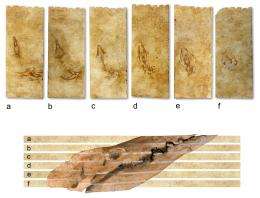Whale fossils show important characters of the transition to water

(PhysOrg.com) -- Decorative stone is often used in buildings for its strength and durability but is not often thought of as a hiding place for fossils. If not for an observant Italian stonecutter, a recently discovered fossil whale specimen from Egypt might have become part of the edifice of some new skyscraper rather than the focus of a scientific study. This fossil skull and partial rib cage, described in the latest issue of the Journal of Vertebrate Paleontology, show transitional features of a new species of early whale and hint at how it became a fossil in the first place.
Giovanni Bianucci of the Università di Pisa and Philip Gingerich of the University of Michigan collaborated to describe this unique find. “The fossil came from deep in an enormous limestone quarry in Egypt, but it was only recognized to be a fossil skeleton when it was cut into decorative facing stone in Italy. Fortunately it then found its way to the museum in Pisa where it could be studied,” said Bianucci. Working with researchers at museums and universities in Egypt and using Google Earth, Gingerich was able to find and revisit the location of the quarry where the fossil had been quarried.
Because the limestone had already been cut into thick slabs about 1 inch (27mm) thick, details of the specimen could be examined in a way that would normally require destruction of a fossil. The researchers were able to remove the slices of the skull and rib cage from the stone and reposition them as they had been in life. After accomplishing this, they were able to investigate the unusual characters preserved by the fossil and recognize that it represented a new species, dubbed Aegyptocetus tarfa (ay-jip-to-SEE-tus TAR-fa).
Says Gingerich, “Connecting links that are intermediate in geological time, intermediate in morphological form, and intermediate in functional adaptation are the evidence for evolution, and Aegyptocetus tarfa falls right in the middle of what we know about the evolutionary transition of whales from land to sea.” Dating to around 40 million years ago, the fossil documents a transitional stage in the evolution of whales from their terrestrial ancestors to the fully aquatic species we see today. The transitional characters present in this species include a retained sense of smell (which is usually lost in aquatic mammal lineages), an enhanced ability to hear (a characteristic of later and modern whales), and the ability to still haul itself out of the water, similar to modern seals.
In addition to these transitional features, the fossil had some other surprises. Bite marks on its ribs may show that the whale was attacked by a shark before dying and becoming fossilized. “It is rare to find evidence of behavioral interaction in the fossil record, but here we have evidence of an early semiaquatic whale being attacked by a shark,” says Bianucci. In addition, small scars on the bones are the burrows of ancient barnacles, giving some idea about how long the carcass sat on the bottom of the ocean before being buried.
The researchers suspect there may be other fossils hidden in the limestone and are making connections with stonecutters who work with the rock from the quarry so that they can ask them to keep an eye out for other ancient treasures.
More information: The article appears in the Journal of Vertebrate Paleontology 31(6), DOI:10.1080/02724634.2011.607985
Provided by Society of Vertebrate Paleontology


















